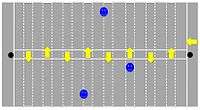Kho kho
 Boys in a Government School in Haryana, India playing kho-kho | |
| Characteristics | |
|---|---|
| Team members | 12 players per side. 9 in the field and 3 extra |
Kho kho (Punjabi: ਖੋ-ਖੋ) is a tag sport from the Indian subcontinent. It is played by teams of twelve players, of which nine enter the field, who try to avoid being touched by members of the opposing team.[1] It is one of the two most popular traditional tag games of the South Asia, the other being kabbadi.[2] Apart from South Asia, it is also played in South Africa.[3]
History
In 1987, The Asian Kho Kho Federation was established during the 3rd SAF Games in Kolkata, India. Member countries included India, Bangladesh, Pakistan, Sri Lanka, Nepal and Maldives. The 1st Asian Championship was held at Kolkata in 1996 and the second championship at Dhaka in Bangladesh. India, Sri Lanka, Pakistan, Nepal, Japan, Thailand and Bangladesh were participants of the championship.
Rules, field dimensions and equipment used
Each team consists of 12 players, but only 9 players take the field. A match consists of two innings with each inning consisting of chasing and running turns of 9 minutes each. One team sits/kneels in the middle of the court, in a row, with adjacent members facing opposite directions. The runners play in the field, 3 at a time and the team that takes the shortest time to tag/tap all the opponents in the field, wins. There is a pole on each end and the runner can go between two players who are sitting in zig zag manner, but the chaser is not allowed to turn back while running and go between the players. But chaser can go to pole and touch it and can go back or go to other side.

A kho kho playground (or pitch) is rectangular.[4] It is 30 metres in length and 19 metres in width. There are two rectangles at the end. Length of the rectangle is 16 metres and the width is 2.75 metres. In the middle of these two rectangles, there are two wooden poles. The central lane is 23.50 metres long and 30 cm wide. There are eight cross lanes which lie across central lane, length of the cross lanes, are 16 metres and width 30 cm. It makes the small rectangles and each of it is 16 metres in length and 2.3 metres in breadth,(the two rectangles of near by the wooden poles are 2.5 metres width) at right angles to the central lane and divided equally into two parts of 7.85 metres each by central lane. At the end of central lane, the free zone tangent to the post-line, two smooth wooden posts are fixed, 120 cm height from the ground and their circumference is not less than 30 cm and not more than 40 cm
The equipment used in kho kho are poles/post, strings, metallic measuring tape, lime powder, wire nails, two watches, types of rings having inner circumference of 30 cm and 40 cm, score shots (like a whistle, for instance), and stationery to write results. [5]
References
- ↑ "Tripura KHO KHO Association @ Tripura4u". Retrieved 28 March 2011.
- ↑ Peter A. Hastie (1 July 2010). Student-Designed Games: Strategies for Promoting Creativity, Cooperation, and Skill Development. Human Kinetics. pp. 52–. ISBN 978-0-7360-8590-8. Retrieved 7 March 2012.
- ↑ A trip through SA's indigenous games. sowetanlive.co.za 14 March 2012.
- ↑ "Kho Kho Field". WebIndia123.
- ↑ "Equipment". Sports.Indiapress.org.
Further reading
- Gupta, K.; Gupta, Amita, eds. (2006), Concise Encyclopaedia of India, 3, New Delhi: Atlantic, pp. 966, 986, ISBN 81-269-0639-1
External links
- http://library.thinkquest.org/11372/data/kho-kho1.htm
- http://www.khokhoindia.com
- Kho-Kho Federation of India webpage
- http://www.olympic.ind.in/images/KhoKho.pdf